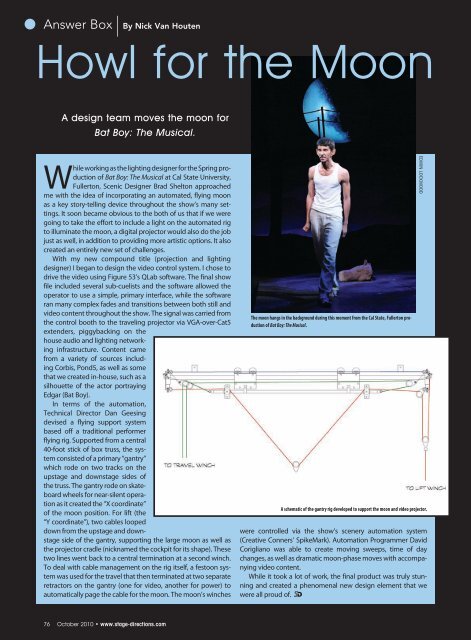Download a PDF - Stage Directions Magazine
Download a PDF - Stage Directions Magazine
Download a PDF - Stage Directions Magazine
Create successful ePaper yourself
Turn your PDF publications into a flip-book with our unique Google optimized e-Paper software.
Answer Box<br />
|<br />
By Nick Van Houten<br />
Howl for the Moon<br />
A design team moves the moon for<br />
Bat Boy: The Musical.<br />
While working as the lighting designer for the Spring production<br />
of Bat Boy: The Musical at Cal State University,<br />
Fullerton, Scenic Designer Brad Shelton approached<br />
me with the idea of incorporating an automated, flying moon<br />
as a key story-telling device throughout the show’s many settings.<br />
It soon became obvious to the both of us that if we were<br />
going to take the effort to include a light on the automated rig<br />
to illuminate the moon, a digital projector would also do the job<br />
just as well, in addition to providing more artistic options. It also<br />
created an entirely new set of challenges.<br />
With my new compound title (projection and lighting<br />
designer) I began to design the video control system. I chose to<br />
drive the video using Figure 53’s QLab software. The final show<br />
file included several sub-cuelists and the software allowed the<br />
operator to use a simple, primary interface, while the software<br />
ran many complex fades and transitions between both still and<br />
video content throughout the show. The signal was carried from<br />
the control booth to the traveling projector via VGA-over-Cat5<br />
extenders, piggybacking on the<br />
house audio and lighting networking<br />
infrastructure. Content came<br />
from a variety of sources including<br />
Corbis, Pond5, as well as some<br />
that we created in-house, such as a<br />
silhouette of the actor portraying<br />
Edgar (Bat Boy).<br />
In terms of the automation,<br />
Technical Director Dan Geesing<br />
devised a flying support system<br />
based off a traditional performer<br />
flying rig. Supported from a central<br />
40-foot stick of box truss, the system<br />
consisted of a primary “gantry”<br />
which rode on two tracks on the<br />
upstage and downstage sides of<br />
the truss. The gantry rode on skateboard<br />
wheels for near-silent operation<br />
as it created the “X coordinate”<br />
of the moon position. For lift (the<br />
“Y coordinate”), two cables looped<br />
down from the upstage and downstage<br />
side of the gantry, supporting the large moon as well as<br />
the projector cradle (nicknamed the cockpit for its shape). These<br />
two lines went back to a central termination at a second winch.<br />
To deal with cable management on the rig itself, a festoon system<br />
was used for the travel that then terminated at two separate<br />
retractors on the gantry (one for video, another for power) to<br />
automatically page the cable for the moon. The moon’s winches<br />
The moon hangs in the background during this moment from the Cal State, Fullerton production<br />
of Bat Boy: The Musical.<br />
A schematic of the gantry rig developed to support the moon and video projector.<br />
were controlled via the show’s scenery automation system<br />
(Creative Conners’ SpikeMark). Automation Programmer David<br />
Corigliano was able to create moving sweeps, time of day<br />
changes, as well as dramatic moon-phase moves with accompanying<br />
video content.<br />
While it took a lot of work, the final product was truly stunning<br />
and created a phenomenal new design element that we<br />
were all proud of.<br />
Edwin Lockwood<br />
76 October 2010 • www.stage-directions.com

















